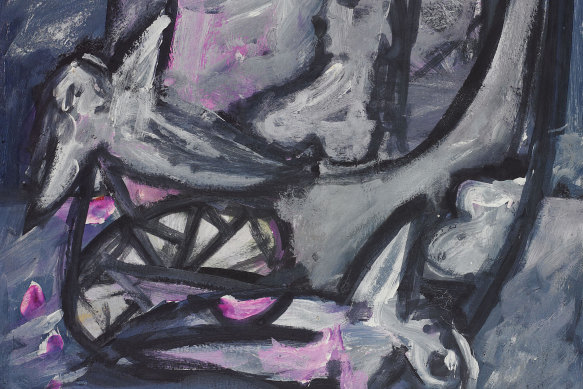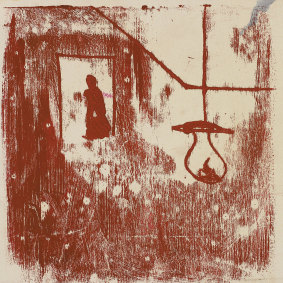Before artist Sidney Nolan became well-known for his Ned Kelly works – a series of paintings depicting the famous bushranger as a simplified series of dark squares and rectangles set against colorful backdrops – he was an army deserter living in an artistic paradise of sorts.
In the late 1930s Nolan met art patrons John and Sunday Reed. By the early 1940s he was living with them, producing a prodigious amount of art, and he and Sunday were entangled in an open and torrid love affair. Their home – now the Heide Museum of Modern Art in Melbourne’s east – was where he began to experiment and develop as an artist. Now a rare collection of 47 works produced by Nolan during this period are going up for auction.

Angels and Figure (1941) by Sidney Nolan.
Valued collectively at around $500,000, these pieces give a glimpse into the life and mind and development of Nolan in his earliest days as an artist, before he became famous, and before the implosion of his relationship which saw him leave Sunday Reed, Heide, and these works behind.
It’s an eclectic bunch, ranging from landscapes to prints to abstract. Some were included in his first exhibition, held in a newsagency window in Heidelberg, Melbourne, and none were sold at the time.

Figures in an interior with hanging lamp, Kelly Series (1947) by Sidney Nolan.
Alex Clark, Australian and International Art Specialist at Bonhams auction house, highlights how unusual it is for so many works from this period to come up for sale together. Nolan was prolific across his career, “so there’s always works coming up – but these early works do n’t come up that often, and not in a context like this, where it’s a large group of unique works.”
These pieces come from the collection of Lady Mary Nolan, who died in 2016, and before that were from the collection of Sidney Nolan, who died in 1992. Most works from this period were donated to institutions – these are the ones that Nolan decided to hold on to after getting them back from the Reeds in the late 1950s.
“A lot of people probably know him for his post ’60s works, which is when he became really famous, both nationally and internationally, but not many people are as familiar with his earlier works from the late ’30s, through to the mid’ 40s.”
Pieces from this personal archive have been sold off here and there across the years, but “these particular works have been held back by the estate because they’re rather important early works,” says Clark.
